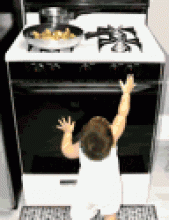A 2-month-old boy was transferred from a community hospital to a tertiary care pediatric centre for work-up of recurrent Escherichia coli meningitis. The patient was born at 34 weeks because of premature rupture of membranes; his mother had a history of E. coli bacteriuria. His birth weight was 2.2 kg. He received treatment for sepsis and was discharged home but was readmitted 1 week later because of E. coli sepsis and meningitis. One week after the second discharge, the baby was admitted a third time and transferred to our hospital with a diagnosis of recurrent E. coli meningitis.
Examination revealed an alert baby with a head circumference of 35.5 cm, and weight and height in the 50th percentile. The anterior fontanelle was full, and a downward gaze (“setting-sun” sign) was noticed intermittently. Deep-tendon reflexes were brisk, and plantar responses were extensor. The remaining findings on physical examination were unremarkable.
Within a week after admission, persistent downward gaze (Fig. 1) was noticed, as was an absence of visual fixation and following. The fontanelle became fuller, and the patient's head circumference rapidly increased to 39 cm. A CT scan showed marked hydrocephalus (Fig. 2). An external ventricular derivation was inserted. Immediately after the procedure, the fontanelle became flat, the setting-sun sign disappeared, and the patient became more alert and started focusing.
Fig. 1: Infant with persistent downward gaze (“setting-sun” eye phenomenon).
Fig. 2: CT scan, showing marked hydrocephalus in infant with setting-sun eye phenomenon.
The setting-sun phenomenon is an ophthalmologic sign in young children resulting from upward-gaze paresis. In this condition, the eyes appear driven downward, the sclera may be seen between the upper eyelid and the iris, and part of the lower pupil may be covered by the lower eyelid. Pathogenesis of this sign is not well understood, but it seems to be related to aqueductal distention with compression of periaqueductal structures secondary to increased intracranial pressure.1 However, it can also be transiently elicited in healthy infants up to 7 months of age by changes of position or removal of light (benign setting-sun phenomenon). The benign form might represent immaturity of the reflex systems controlling eye movements.2,3
When persistent, this sign is one of the most frequent markers of elevated intracranial pressure, appearing in 40% of children with hydrocephalus (of any cause) and in 13% of patients with ventriculoperitoneal shunt dysfunction.4 It is an earlier sign of hydrocephalus than enlarged head circumference, full fontanelle, separation of sutures, irritability or vomiting. Consequently, this sign is a valuable early warning of an entity requiring prompt neuroimaging and urgent surgical intervention.
Footnotes
-
Competing interests: None declared.













